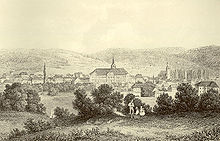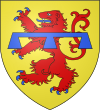Palatine Zweibrücken
Duchy of Palatinate-Zweibrücken | |||||||||||
|---|---|---|---|---|---|---|---|---|---|---|---|
| 1459–1797 | |||||||||||
 Palatine Zweibrücken (green) and other Palatine lines, ca. 1700. | |||||||||||
| Status | Duchy | ||||||||||
| Capital | Zweibrücken | ||||||||||
| Common languages | German | ||||||||||
| Religion |
| ||||||||||
| Government | Duchy | ||||||||||
| Duke | |||||||||||
| Historical era | |||||||||||
• Split from Palatinate-Simmern and Zweibrücken, unified with County Palatine of Veldenz | 1459 | ||||||||||
| 1797 | |||||||||||
| |||||||||||
The Duchy of Palatinate-Zweibrücken (
Overview
Palatine Zweibrücken was established as a separate principality in 1459, when
Palatine Zweibrücken ceased to exist in 1797 when it was annexed by France. After the Congress of Vienna in 1815, some parts of it were returned to the last Duke, King Maximilian I Joseph of Bavaria,[1] who joined them with other former territories on the left bank of the Rhine to form the Rheinkreis, later the Rhenish Palatinate.
Origins
The
Extent

When Palatine Zweibrücken was created in 1444, it consisted of the
Territories held in 1784
An
- Oberamt Zweibrücken
- Oberamt Homburg (acquired in 1755 in a territorial exchange with Nassau-Saarbrücken)
- Oberamt Lichtenberg at Kusel (originally part of the County of Veldenz)
- Oberamt Meisenheim (originally part of the County of Veldenz)
- Oberamt Trarbach, including Kröv (originally part of the County of Sponheim)
- Amt Allenbach (originally part of the County of Sponheim)
- Oberamt and Strümmich (originally part of the County of Sponheim)
- Oberamt Bergzabern including the Vogtei of Kleeburg, Annweiler am Trifels, Wegelnburg
- Amt Nohfelden
- Oberamt Gutenberg (acquired in 1768 in a territorial exchange with the Electoral Palatinate)
- Amt Seltz and Hagenbach
- Lordship of Bischwiller
Guttenberg, Seltz and Hagenbach and Bischwiller were French fiefs, the others were German.[1]
History
15th century
During the reign of Louis I, who conducted four unsuccessful feuds against his cousin
Initially, Meisenheim was the capital. In 1477, the Electoral Palatinate threatened Meisenheim and the capital had to be moved to Zweibrücken, where it remained until 1793.
Alexander's Church (Alexanderskirche) is the oldest church in Zweibrücken, a late-Gothic Protestant hall church built from 1493 to 1514 as a gift from Alexander, Count Palatine of Zweibrücken after his return from a pilgrimage to the Holy Land; descendant counts and dukes of the line are buried in its crypt.[2]
16th century
After Louis' death, the duchy was not divided. His testament required dukes
Alexander and Louis II introduced
17th century
During the
The 1697
18th century


The
From 1725 to 1778, the counts palatine resided in Zweibrücken Castle; they then moved to Karlsberg Castle near Homburg, to emphasize their claim to inherit the Duchy of Bavaria. Members of the ruling family were buried in the castle church in Meisenheim and later in the Alexander Church in Zweibrücken (badly damaged in World War II).
Gustav was the last Count Palatine of the Kleeburg line; when he died in 1731 without a male heir,
During Christian IV's reign, the fragmentation of the area was reduced by exchange of territories. For example, in 1768, Odernheim and half of Molsheim where transferred to the Electoral Palatinate, in exchange for Neuburg, the district of Hagenbach, district of Selz and Selz Abbey.[1] In 1776, the "Hinder" County of Sponheim was divided between Zweibrücken and Baden, with Zweibrücken receiving Kastellaun, Traben-Trarbach with Starkenburg and Allenbach, and Baden receiving Birkenfeld, Frauenburg and Herrstein.[1]
In 1793 the
Christian IV Reign, Regiment Royal Deux-Ponts (Zweibrücken) French Expeditionary Regiments in the American Revolution.[clarification needed]
19th century
Palatine Zweibrücken formally ceased to exist by the Treaty of Lunéville in 1801, which reaffirmed and recognised internationally the French acquisitions laid out in the Treaty of Campo Formio.
In 1806, Maximilian Joseph became King of Bavaria, as Maximilian I Joseph,
After the Congress of Vienna in 1815, some parts of the former County Palatine were returned to Maximilian Joseph, now King Maximilian I Joseph of Bavaria,[1] together with parts of the former Electorate and territories formerly owned by different families. Maximilian Joseph merged these left-bank territories to form the Rheinkreis, known after 1837 simply as Pfalz (Palatinate) and sometimes called Rheinpfalz (Rhenish Palatinate). This area largely corresponds with the modern Palatinate region and Saarpfalz-Kreis.
Administration
In the duchy, there was no authority that would have limited the power of the Duke. Even the urban population were legally serfs until that status was repealed by John I on 21 April 1571 (although the situation in the city of Zweibrücken had already been somewhat eased by decrees from the years 1352 and 1483). Young men were required to serve six years in the militia.
The highest administrative body was the cabinet; in whose meetings the Duke participated. The treasury was responsible for finance, mining and forestry. There was no separation between the judiciary and the administration. Justice was meted out by officials with the rank of Schultheiß. The highest court in the land was the Court of Appeals in Zweibrücken; its traditions are continued today by Zweibrücken's Oberlandesgericht. After 1774, appeals from the court in Zweibrücken to the Reichskammergericht were no longer possible. In the Alsatian parts of the country, however, appeals to the Conseil souverain d’Alsace in Colmar were possible from about 1680. Important statutes were the Court Judicial Order of 1605, the Lower Court Order of 1657, and later the Criminal Procedure of 1724, and Marriage and Guardianship Regulations. In areas where no state law was available, imperial law applied.
Administratively, the country was divided into eight districts: Zweibrücken, Homburg, Lichtenberg, Meisenheim, Trarbach, Kastellaun, Bergzabern and Guttenberg.

Religion and church
In the 1520s,
After Wolfgang's death, his son John I joined the
Administratively, the Reformed Church was organized similarly to the secular authorities: each secular district corresponded to a church district headed by a
From the beginning, the lay element played a special role in the church in Zweibrücken. The Reformation revived the ancient office of the Elder, a layman chosen by the community, who would supervise the lifestyle of the congregation, the pastor, the funds and the property of the parish.
Ducal arms

Around 1720, Palatinate-Zweibrücken added the symbols of the
List of Counts Palatine Zweibrücken

- Stephen, Count 1410-1459 (1385-1459)
- Ludwig I the Black, Count 1459-1489 (1424-1489), second son
- Kaspar, Count with his brother 1489-1490 (1458-1527), deposed by his brother
- Alexander the Lame, Count 1489-1514 (1462-1514)
- Ludwig II the Younger, Count 1514-1532 (1502-1532)
- Wolfgang, Count 1532-1569 (1526-1569)
- Johann I the Lame, Count 1569-1604 (1550-1604), second son
- Johann II the Younger, Count 1604-1635 (1584-1635)
- Friedrich, Count 1635-1661 (1616-1661)
- Friedrich Kasimir, Count Palatine of Zweibrücken-Landsberg (1585-1645)
- Friedrich Ludwig, Count 1661-1681 (1619-1681)
- Johann Kasimir, Count Palatine of Zweibrücken-Kleeburg (1589-1652)
- Charles X Gustav of Swedenand Count Palatine of Zweibrücken-Kleeburg (1622-1660)
- Kingdom of Sweden(1655-1697)
- Charles XII of Sweden, Count 1697–1718, in personal union with the Kingdom of Sweden (1682-1718)
- King of Polandin exile (1714 - 1719)
- Charles XII of Sweden, Count 1697–1718, in personal union with the Kingdom of Sweden (1682-1718)
- Count Palatine Adolf Johann I of Zweibrücken-Kleeburg (1629-1689)
- Gustav Samuel Leopold, Count 1718-1731 (1670-1731)
- Karl I, Count Palatine of Zweibrücken-Birkenfeld (1560-1600)
- Christian I, Count Palatine of Birkenfeld-Bischweiler (1598-1654)
- Christian II, Count Palatine of Zweibrücken-Birkenfeld (1637-1717)
- Christian III, Count 1731/34-1735 (1674-1735)
- Christian IV, Count 1735-1775 (1722-1775)
- Friedrich Michael, Count Palatine of Zweibrücken-Birkenfeld (1724-1767)
- Karl II August, Count 1775-1795 (1746-1795)
- Maximilian I, Count 1795–1805, in personal union with the Electorate of Bavaria from 1799 (1756-1825)
- Christian III, Count 1731/34-1735 (1674-1735)
- Christian II, Count Palatine of Zweibrücken-Birkenfeld (1637-1717)
- Christian I, Count Palatine of Birkenfeld-Bischweiler (1598-1654)
- Johann I the Lame, Count 1569-1604 (1550-1604), second son
- Wolfgang, Count 1532-1569 (1526-1569)
- Ludwig II the Younger, Count 1514-1532 (1502-1532)
- Ludwig I the Black, Count 1459-1489 (1424-1489), second son
See also
- Royal House of Swedenfrom 1654 to 1720
References
- ^ ISBN 2-901138-04-7.
- OCLC 34658300.
- ^ Georg Christian Joannis: Kalenderarbeiten, Zweibrücken 1825, p. 15 ff Online



